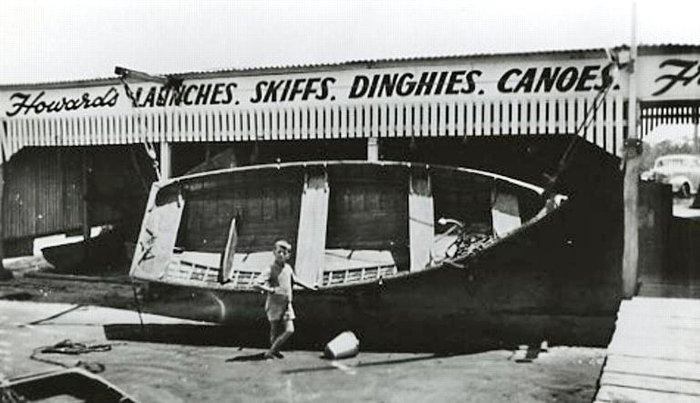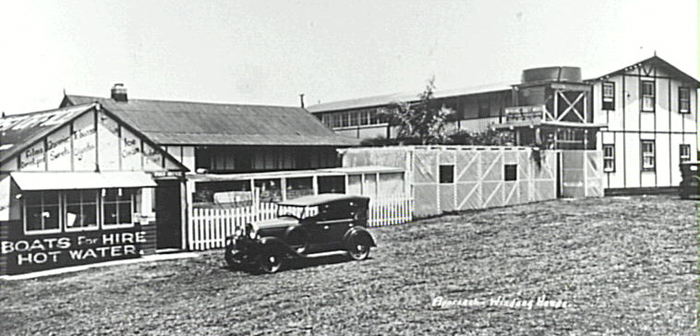Parish: Wollongong
County: Camden
Windang is the southernmost coastal suburb in the Wollongong Local Government Area, set on the shores of Lake Illawarra and the ocean.
Local communities of Aboriginal people were the original inhabitants and Traditional Custodians of Illawarra Land. Their dialect is a variant of the Dharawal language.
Before European settlement, the Aboriginal people of the region lived in small family groups with complicated social structures and close associations with specific areas.
Suburb boundaries do not reflect the cultural boundaries of the local Aboriginal community.
Traditional Custodians today are descendants of the original inhabitants and have ongoing spiritual and cultural ties to the Land and waterways where their ancestors lived.
Windang is an Aboriginal word meaning "scene of a fight".
Windang is said to have been 'founded' by William Turnbull. Turnbull purchased some land in the area in 1920 and erected a two story building called 'Wyndang House'.
In 1926 the Post Office attached to this house was officially named Windang Post Office following a submission from Turnbull to have the name changed from the unofficial Lake Illawarra Post Office. The request was granted on the proviso that "the correct spelling be adopted namely Windang, which is that of the Island and Trigonometrical Station thereon in the vicinity".
Windang Island
The native name for Windang Island was "Kauyanggang" (Kanyangang) which meant "saved by the big bear who pulled the Island into its present position". The Island was called Windang Island as far back as 1848 when it was described in William Henry Wells' Geographical Dictionary as "an island situated at the entrance of Lake Illawarra, in the county of Camden, NSW".
Land grants
The area now described as the suburb of Windang appears to have been designated as a Township Reserve on an 1834 map of the Illawarra drawn by the Surveyor H F White. This land is adjacent to the Five Islands Farm originally known as Illawarra Farm, which was granted to David Allan. The name was changed to Five Islands Estate upon purchase by William Charles Wentworth (McDonald c1988).
In 1896 a certain part of the peninsula was gazetted for defence purposes and in 1920 other parts for public recreation. Timber Licenses were granted on a timber reserve at the end of Perkins Beach (Parish of Wollongong map 12th ed).
William Turnbull
In 1920 William Turnbull established his Belwarra Estate at the northern point of the Lake entrance. Windang House was built by Mr Turnbull in 1920 as a family home and guest house.
Tourism and recreational fishing have always been of major importance in the area. Guest houses sprung up in the 1930s to cater for tourists, and the Windang Camping Reserves have never ceased to be popular (Picturesque Illawarra: the garden of NSW, 1940).
Preparations for the construction of a breakwater on the northern side of Windang Island and a dredged channel began in 1890 to enable ocean going vessels to access the lake entrance. The scheme was abandoned in the early 1900s (Barwick-Hooke, c1988).
No matter what the costs of motoring were, touring and…..picnicking brought growth and commerce to more dispersed areas. In 1927 more than 2000 holidaymakers reportedly camped at the northern side of the entrance to Lake Illawarra (Urban Illawarra c1977).
Windang Boatshed
The boatshed was built by Ben Howard in 1936. Attached to the shed was a shop and seafood restaurant which Mr Howard and his wife Mary operated (Neels, 1988; Harrison, 1993).

Image: Windang Boatshed, image number P17918.
Windang House
Windang House was a two storey wooden residence located near the Lake bridge. Originally known as Wyndang House, it was built by Mr William Turnbull in 1920 as a family home and guest house. A post office and Hooper's general store were attached. The house was sold in 1927 as part of subdivision of the land, and it remained as a guest house until it was demolished in 1980 (Illawarra Images).

Image: Windang House c1931, image number P16851.
In the past Lake Illawarra and surrounds have been degraded by urban and industrial development. Increased runoff into the lake including silt, industrial pollutants and nutrients such as fertilisers and sewage resulted in the lake losing its natural filters of wetlands and vegetation around its edges. The formation of the Lake Illawarra Authority and the foreshore improvement works undertaken has highlighted the ecological value of the public land around the lake.
Lake Illawarra Authority had the task of reviving and restoring the lake so that it would continue to provide an attractive recreational and tourism resource. The NSW State Government disbanded the Lake Illawarra Authority on 1 July 2014 and transferred the management of Lake land and assets to various management agencies, including Wollongong and Shellharbour City Councils.
The sandy shoals of the entrance channel provide feeding and roosting sites for many wader species. The number and variety of bird species varies considerably with the season. The foreshore area provides suitable habitats for several rodentia species (Environmental Defender's Office NSW, Weekly bulletin).
Bird life of Lake Illawarra
Pelicans, Black Swan, Tern, Egret, Cormorant, Spoonbill, White faced Heron, Curlew, Teal, Ibis and Duck are the most prolific species of birds found on the Lake. The main source of food for these birds is fish, weed, microbes and worms found in and around the Lake's edge (Massey, 1991).
Little Tern
This small partly migratory seabird is listed as an Endangered Species on Schedule 1 of the NSW Threatened Species Conservation Act , 1995. A very small colony returns to breed every year on a site at Windang near the Lake inlet (NSW National Parks and Wildlife Service).
Filamentous algae
This is a nutrient found in the Lake which is important in the growth and development of many species of estuarian fish (Massey, 1991).
Weed in Lake Illawarra
The weed growing on the lake flats provides food for a variety of fish and birds and is vital in the ecological food chain. If the weed beds are touched in anyway the impact would be devastating to the fish and bird life of the Lake (Massey, 1991).
Fish stocks in Lake Illawarra
Fish stocks can fluctuate from year to year depending on weather conditions. Species of fish caught in the Lake include Luderick (Black fish), Whiting, Bream, Tailor, Jewfish, Yellowtail, Mullet, Dusky Flathead, Mudcrab and School Prawns (Massey, 1991).
Lake Improvement works near Windang
Entrance improvement works have included the construction of an internal rock wall and an external sea wall through the surf to connect with Windang Island; installation of a sand dune extending almost to the island to create a shallow waterway as a bird sanctuary; and construction of a boat ramp and channel.
See Council's website for more information about the management of Lake Illawarra.
| Date | Event |
|---|---|
| 1796 | Landing of Bass and Flinders in the Tom Thumb at the mouth of Lake Illawarra |
| 1824 | Hume report to the Government regarding the possibility of settlement in the area |
| 1885 | Plans for overseas harbour out of the Lake (to export coal in particular) are abandoned when reef is discovered near Windang Island |
| 1919 | W. Turnbull settles at the north point entrance to the Lake, known as Belwarra Estate |
| 1920 | Provision made at Windang for camping |
| 1920 | Windang House built |
| 1926 | Sale of Turnbull's subdivision |
| 1926 | Road linking Port Kembla and Shellharbour proposed by Shellharbour Council |
| 1936 | 32,000 pounds made available to build bridge across the lake |
| 1938 | Lake Illawarra bridge officially opened |
| 1939 | Large land sale around Windang House to development company |
| 1942 | Windang Public School established |
| 1944 | Water supply extended across bridge to Lake Illawarra South |
| 1948 | Sand removal and dune stabilisation works begin on the northern end of the peninsula |
| 1948 | Bridge damaged by Teredo worms |
| 1956 | Lake Illawarra Hotel built in Windang |
| 1957 | Windang Surf Club established |
| 1966 | Construction of Windang Surf Club Clubhouse |
| 1967 | Start of sand dredging at entrance and stabilisation of drift sands on Windang Peninsula to create parklands |
| 1969 | Wollongong Aerial Patrol operates from Perkins Beach |
| 1969 | Man-made entrance to Lake Illawarra closes |
| 1976 | Concept of a single Lake Illawarra Authority recommended |
| 1977 | NSW Government announces Public Works engineering study of methods to improve lake entrance |
| 1984 | Floods |
| 1987 | Lake Illawarra Authority Act proclaimed |
| 1988 | Bicentennial project completed; Tom Thumb Garden |
| 1988 | Windang boat ramp constructed |
| 1989 | Unveiling of sculpture at Tom Thumb Garden to commemorate and symbolise the Aboriginal dreamtime story of the whale and the koala and the creation of Windang Island |
| 1989 | Federal government funds provided for deep sea boat ramp project |
| 1991 | Floods |
| 1994 | Windang Beach and Garden playground opens |
| 1994 | Windang homes threatened by bush fire |
| 1996 | Formation of Lake Illawarra Authority |
| 1996 | Windang Peninsula Heritage Park established to preserve the Illawarra’s Aboriginal heritage and protect native flora and fauna |
| 1997 | Conservation works begin on Windang Island |
| 1997 | Under Mabo legislation over 2.5 ha of beachfront strip Crown land on Windang Peninsula reverts to ownership by Illawarra Aboriginal Land Council |
| 1999 | Lake entrance improvements begin |
| 2005 | Plan for further Lake entrance improvement works goes on public exhibition |
| 2006 | Demolition of Windang boatshed |
| 2014 | Lake Illawarra Authority disbanded on on 1 July; management of Lake Illawarra and surrounds transferred to various agencies, including Wollongong and Shellharbour City Councils |
Top image: Windang Bridge, 1932. See image details on our catalogue
